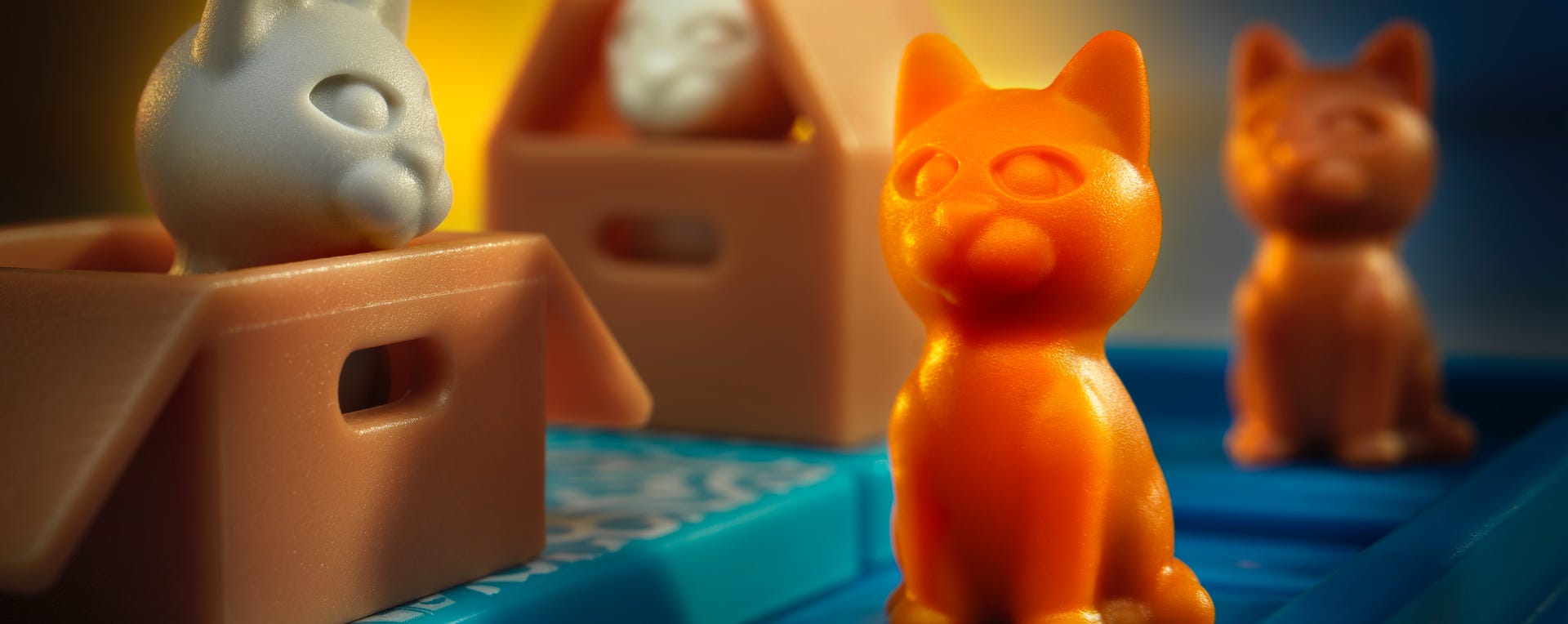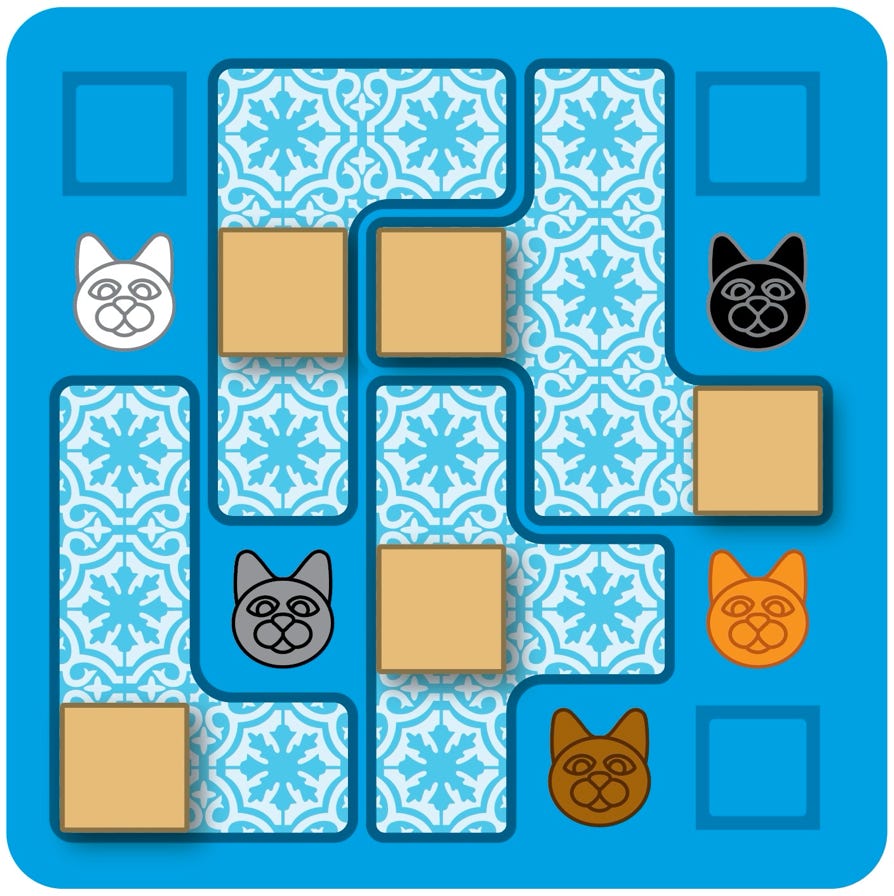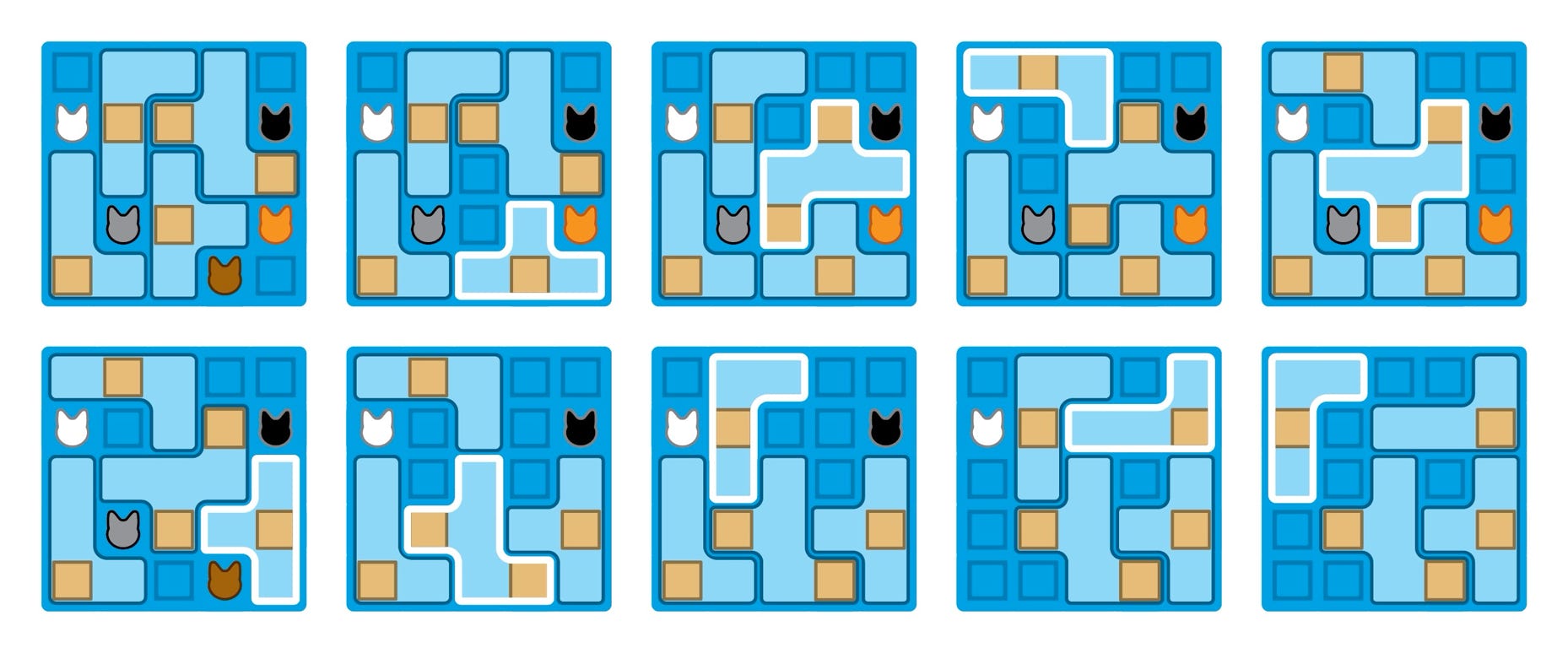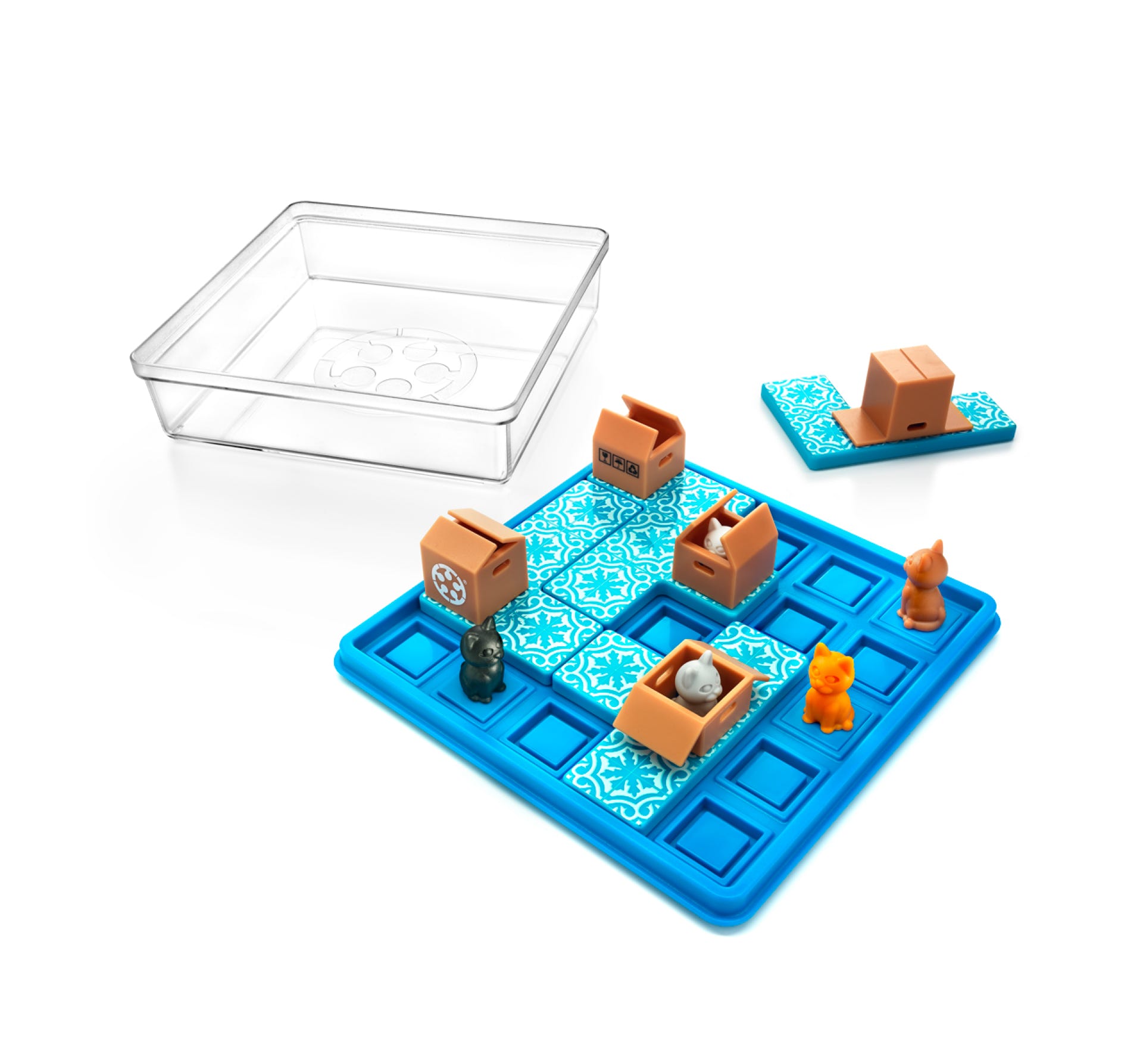
Cats & Boxes
The product development of Cats and Boxes (for SmartGames)
Raf Peeters, January 2023

Although not necessary, it’s always more fun to design something that you personally like. As someone who has always loved cats, I've wanted to create a SmartGame featuring them for years. I had many cats when I was a child (although you never really own a cat, it’s more visa versa). And, as anyone knows who has spent some time around cats (or more than 5 minutes on Instagram or YouTube), they love to hide in cardboard boxes.
THINK INSIDE THE BOX
So the idea for this game started with the image of cute cats hiding inside boxes. Some would be hidden completely, other cats would be peeking through the halfopen lids of boxes The puzzle pieces are designed similar to the houses of "Three Little Piggies Deluxe," with a hole in the bottom of each piece and a box that can be placed over a cat. However, this is not a game for young kids! And it’s not a packing problem either (pun not intended). This is a sequential movement puzzle! The goal is to move the 4 puzzle pieces one by one until all cats sit inside boxes. There are always 5 cats and 5 boxes but only 4 puzzle pieces. Therefor one piece contains 2 boxes. There is only one important rule: you should never lift up more than one puzzle piece at the same time. You must place it back on the game board anywhere you want … as long as it fits. Of course most of the time it doesn’t fit, because cats or other puzzle pieces make it impossible. Once a box covers a cat, you are still allowed to remove it later and place it elsewhere. Cat’s can’t of course be moved.
This game mechanic is related to sliding puzzles. But instead of moving a puzzle piece to an adjacent square, in this sequential movement puzzle you can move them anywhere they fit. As far as I am aware this idea was first explored by Dries de Clercq in the “Flying Piece Puzzle” and later used in “Dig It” from Foxmind. What sets Cats & Boxes apart from these games, is that not only the puzzle pieces but also the cats limit the placement options. But the cats do it in a different way. If a cat position corresponds to a box, it doesn’t block the placement. If not, it does. So there are a lot of constantly changing variables to consider when you try to solve a challenge.
When my colleague Alain wrote a program to calculate the number of steps to solve the challenges, we found that the hardest challenge had 33 moves. But play testing quickly made it clear that any challenge with more than 10 steps was already really hard. So those challenges are only used for the Master and Wizard level. It was the first time I had to adjust my selection of challenges several times, making them easier again and again, until the difficulty level was balanced and similar to other SmartGames. That’s another reason why I like this game so much. It comes very close to my ideal game: “creating something complex with very simple game rules”.
All challenges in the STARTER level can be solved in 4 steps. Since there are only 4 puzzle pieces, you know that every step will result in the final position of a puzzle piece (with a cat inside a box). To make it even simpler, the first 4 challenges indicate in which order you have to move these pieces (although other options are possible). Challenges in harder levels require more steps. This often means that you cover a cat with a box, only to move that box later to somewhere else or on top of another cat. For most people this is probably hard to visualize, that’s why challenges with more than 4 steps become immediately a lot harder. The good thing is that you can’t do anything wrong in this game if you don’t pick up more than one piece at the same time. And believe me, you certainly will be tempted to do that. And you also don’t need to reset the game if you don’t want to. You can use as many steps as you need, even if a challenge says that you can solve it in a few. But although the challenges are challenging, you can do a lot of deduction. For example, the puzzle piece with two boxes can ultimately only be placed on two cats that sit in the same relative position (like a horse movement in chess). And another puzzle piece is often the only one that can be used to cover a cat in the corner of the game board, because of the position of the box on that piece.
The heads of the cats are similar to the ones we designed for Walk the Dog, but now the cats have a sitting position to make them fit inside the boxes. All boxes are slightly different from each other, just to give some visual variation. But their appearance doesn’t affect gameplay. When we received the first samples, we liked the 3D look of the game, but it was missing something because everything is so simple. We tried to print tapestry on the puzzle pieces but eventually we settled with the artwork of old ceramic tiles. This links somehow to the work of my wife, who is a ceramist (although she doesn’t make any tiles).
And, for an added bonus, there's an Easter egg hidden in the game that leads to extra challenges, but I am not going to tell you of course where to find it. This game will become available in Spring 2023.
UPDATE 2024: If you are not really a cat person, there is now also a SmartGame with a dog, named Smart Dog. But it’s completely different, because it’s a connection game instead of a sequential movement puzzle.

Example of challenge 31 of Cats & Boxes

Example of solution 31 of Cats & Boxes that can be solved in 9 steps.

GAME RULES CATS & BOXES
1) Choose a challenge. Place the 5 cats and the 4 puzzle pieces with boxes on the game board as indicated. The orientation of the cats is not important, only their position on the game board matters.
2) Move the puzzle pieces with boxes - one by one - until all cats sit inside a cardboard box:
A) The position of the cats cannot be changed!
B) You can only move ONE box piece at a time. Before you move the next piece, the previous one must be placed back on the game board!
C) When you move a puzzle piece, you are allowed to rotate it and place it anywhere on the game board where it fits. The parts of a puzzle piece without a box cannot be placed on top of cats. Only the boxes will fit on top of cats.
D) Boxes that are placed on top of cats can be moved to a different position later if needed.
3) You have found a solution when each cat is inside a box. The shortest solution can be found at the end of the challenge booklet. The minimum number of moves is indicated next to the challenge, but feel free to use as many moves as you need!
To get you started the early challenges also indicate the order in which pieces need to be moved.
Website ©2023 Raf Peeters
Products and images: © Smart